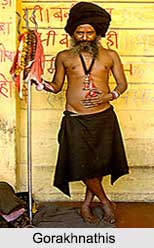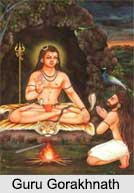 Gorakhnathis is a general descriptive term applied for those yogis who are ardent followers of Gorakhnath, a manifestation of Lord Shiva. Gorakhnathis constitute the principal group and the better class of Yogis. They form a distinct order of Yogis. Kanphata Yogis are found everywhere in India being as widely scattered as any of the severe orders. They are met with separately as mendicants and as hermits, and in groups, in the Northern Deccan, in the central provinces, in Gujarat, in Maharashtra, in the Punjab, in the provinces of the Ganges basin and in Nepal.
Gorakhnathis is a general descriptive term applied for those yogis who are ardent followers of Gorakhnath, a manifestation of Lord Shiva. Gorakhnathis constitute the principal group and the better class of Yogis. They form a distinct order of Yogis. Kanphata Yogis are found everywhere in India being as widely scattered as any of the severe orders. They are met with separately as mendicants and as hermits, and in groups, in the Northern Deccan, in the central provinces, in Gujarat, in Maharashtra, in the Punjab, in the provinces of the Ganges basin and in Nepal.
Etymology of Gorakhnathis
The followers of Gorakhnath are also known as Yogi, Gorakhnatki, Darsani, but most distinctively as Kanphata. The first of these names refers to their traditional practice of the Hatha Yoga, the second to the name of their reputed founder, the third to the huge ear-rings which are one of their distinctive marks, and the fourth to their unique practice of having the cartilage of their ears split for the insertion of the ear-rings. Women of the sect are similarly called Nathni.
It is said that the practice of splitting the ears originated with Gorakhnath, and that the designation Kanphata (literally, Split-eared) was a term of disrespect applied to these Yogis by Muslims. The word Yogi is a general term for ascetics, particularly for those who are endeavouring, by restraint and discipline of the body, to secure union with the Brahman.
Nature of Gorakhnathis
It is not proper for Yogis to live alone; and they are not supposed to wander, but to abide in monasteries, or at temples, and to meditate. Yogis go on pilgrimages, visiting shrines and holy places all over India. However, the yogis make their monasteries their headquarters. Some do live alone, in the jungles, practising Yoga; but hermits of this kind are exceedingly difficult to find.
They pronounce spells and practice palmistry and juggling and tell fortunes. People do homage to Yogis, touching their feet with fingers dipped in holy water, and receive flowers, mangoes and `pieces of coconut` as charms. On the other hand, their curse is feared and this in turn often works as an incentive to do homage.
 Symbolism of Rings in Gorakhnathis
Symbolism of Rings in Gorakhnathis
The distinctive marks of the sect of the Kanphatas are the split-ears (literally means kan-phata) and the huge ear-rings. In the final stage or their ceremony of initiation a specially chosen guru, or teacher, splits the central hollows of both ears with a two edged knife (or razor). The slits are plugged with sticks of `neem` wood and, after the wounds have healed; large rings (mudra) are inserted. These are a symbol of the Yogi`s faith. The Yogi, wearing the mudra, becomes immortal. The rings worn in Western India are almost seven inches in circumference and weigh two and a quarter ounces or more. Weight is dependent upon the substance out of which the rings are made. Rhinoceros horn is a favourite substance for ear-rings. It is not easily broken. The wearing of the ear-rings is considered of great importance. If one is broken, a model in cloth must be substituted before the Yogi may perform his religious duties. A Yogi must protect himself from haying his rings torn out.
Aughars
Aughars are followers of Gorakhnath who have not undergone the final ceremony of having their ears split. A legend that justifies them in not completing initiation says that once two `siddhas` or perfect Yogis tried to split the ears of a candidate, but they found that the slits closed as fast as they were made. So they gave up the attempt. Since then `Aughars` have dispensed with the custom.
Appearance of Gorakhnathis
Both Aughars and Yogis of the sect wear a sacred thread or janeo, which is made by certain members of the order of Gorakhnathis, who taught the art. It is neither made by all Yogis nor by Brahmans. The thread is spun from black sheep`s wool and consists of nine strands. It is worn around the neck. By means of a white cotton cord to the ring are attached, a whistle, `singnad` and a single rudraksa berry.
The singnad is, as the name implies, a whistle made of horn, either of black-buck horn, of stag horn, or of rhinoceros horn. The `singnad` is blown before meals and before morning and evening worship. The use of the whistle was ordered by Shiva. It has a phallic significance associated with it. Some Yogis wear around the loins, a special rope made of black sheep`s wool to which they fasten the loin cloth, `langoti`. It is fastened in front. Most Yogis use a strip of cotton cloth instead of this rope of wool. A third `thread` is worn by some Kanphatas. The cord may be worn as a sort of plaited net-jacket. The Yogi then takes his bowl, his bag and his fire-tongs and goes out to beg. The wearing of the cord is a matter of choice rather than of regulation. An occasional Gorakhnathi wears the usual janeo, or sacred thread of the Hindu. Although Kanphata Yogis wear no distinctive rosaries, they do not use some that are of significance and of interest. One of these consisting of Rudraksha berries is that commonly worn by Shaivites. It is hung around the neck and consists of 32, of 64, of 84, of 108, or even of more berries. Rudraksa berries are significant for the Yogi in several ways. All Yogis use ashes but this practice is not limited to them as all ascetics observe the custom and it is really old. Ashes protect from evil spirits as well.
Accessories of Gorakhnathis
Like most Indian ascetics, Kanphatas have a number of necessary accessories. Among these is the dhuni, or fire, consisting of a smouldering log of wood (one or more), sometimes in a hollow pit. Kanphata Yogis carry a begging bowl, a wallet, fire-tongs, a staff and a crutch.









